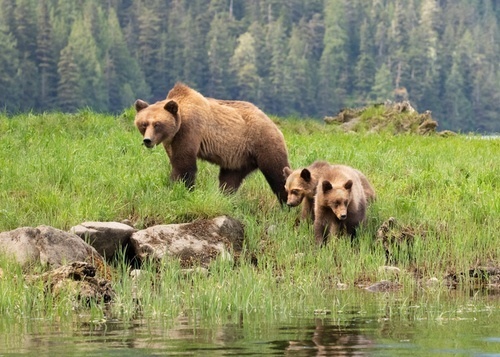
For the second time in a decade, the U.S. Court of Appeals for the Ninth Circuit has invalidated a decision by the U.S. Fish and Wildlife Service (Service) to remove the Greater Yellowstone grizzly bear (Ursus arctos horribilis) population from the federal endangered species list. Crow Indian Tribe v. State of Wyoming, Case No. 18-36038 (9th Cir. July 8, 2020). In 2011, the Ninth Circuit invalidated the decision to delist the Greater Yellowstone grizzly population because the evidence did not support the Service’s conclusion that the decline of white bark pine did not threaten the grizzly population. Greater Yellowstone Ecosystem v. Servheen, 665 F.3d 1015 (9th Cir. 2011). Following in the footsteps of that prior decision, the Ninth Circuit affirmed the 2018 decision of the U.S. District Court in Montana, concluding that the Service did not comply with the Endangered Species Act’s (ESA) requirement to base ESA listing and delisting decisions “solely” on the best scientific data available. The decision addresses important questions concerning the meaning of the “best science” requirement, and the extent to which courts will defer to ESA regulatory decisions.
The court faulted the Service for (1) failing to consider the impact of the delisting on remnant populations of grizzly bears in other portions of Idaho, Montana, and Washington, (2) not applying the best available science in evaluating the long-term risk of lack of genetic diversity in the Greater Yellowstone grizzly population, and (3) eliminating a requirement to recalibrate the estimated size of the grizzly population because of “political pressure” of the states of Idaho, Montana, and Wyoming.
Grizzly bears once thrived across the western coterminous United States, from the West Coast and Southwest to the Great Plains and Texas. By the time the continental U.S. population of the grizzly bear was listed in 1975, the population had dwindled from an estimated 50,000 bears in 1800 to only several hundred.
Since its listing, the population of grizzly bears in the Greater Yellowstone Ecosystem population (20 million acres in Yellowstone and Grand Teton National Parks and adjacent public land) has expanded to about 700 bears. Another estimated 900 bears occupy the Northern Continental Divide Ecosystem (an area that includes Glacier National Park and surrounding areas). The two populations contain a high percentage of the grizzly bears in the continental U.S.
The success of the grizzly bear recovery in the Greater Yellowstone Ecosystem led to proposals to define the Greater Yellowstone population as a “distinct population segment” and then to remove the Greater Yellowstone population from the list of threatened or endangered species. Specifically, while ESA protections for the remnant populations in Idaho, Montana and Washington would remain in place, the Service simultaneously considered whether to delist the population of bears in the Northern Continental Divide. However, the Service did not consider the potential impact of removing ESA protections for the Greater Yellowstone population on the remnant bear populations.
The Ninth Circuit concluded that the Service’s failure to consider the impacts of delisting on remnant populations violated the ESA. It additionally found that the studies relied on by the Service did not support the agency’s conclusion that the Greater Yellowstone population did not face long-term genetic threats without active management measures (translocating Northern Continental Divide bears to Yellowstone). The studies only stated that the Greater Yellowstone population did not face “short-term” risks due to lack of genetic diversity.
Finally, the court concluded that the Service violated the ESA requirement to base a delisting “solely” on the best science available. The court found that the Service’s elimination of its commitment to recalibrate the grizzly population estimate was made--not on the basis of the best available science--but rather in response to the political pressure from the states that comprise the home of the Greater Yellowstone population. Recalibration of the population estimate is the mechanism to allow for an “apples to apples” comparison of the population estimates when the estimation method used by the Service changes.
The Ninth Circuit’s decision is noteworthy because of the iconic status of the Greater Yellowstone grizzly bears under the ESA, and because the decision provides important precedent on the meaning of the “best available science” standard.
- Partner
Robert Thornton specializes in advising state and regional infrastructure authorities on environmental issues regarding large infrastructure projects. He has successfully defended more than $12 billion in regional ...
Nossaman’s Endangered Species Law & Policy blog focuses on news, events, and policies affecting endangered species issues in California and throughout the United States. Topics include listing and critical habitat decisions, conservation and recovery planning, inter-agency consultation, and related developments in law, policy, and science. We also inform readers about regulatory and legislative developments, as well as key court decisions.
Stay Connected
 RSS Feed
RSS Feed
Categories
- Alternative Energy
- Bald and Golden Eagle Protection Act
- Budget
- CEQA
- CESA
- Climate Change
- Congress
- Conservation
- Construction Projects
- Consultation
- Continuing Education
- Court Decisions
- Critical Habitat
- Delisting
- Endangered Species Act
- Event
- Fish & Wildlife Service
- Freedom of Information Act
- Government Administration
- Legal
- Legislation
- Listing
- Litigation
- Migratory Bird
- National Marine Fisheries Service
- NEPA
- Off Shore Wind
- Pacific Northwest
- project
- Publications
- Regulatory Reform
- Sacramento-San Joaquin Delta
- SEPA
- Speaking Engagements
- Supreme Court
- Texas
- Timberland
- Water Issues

